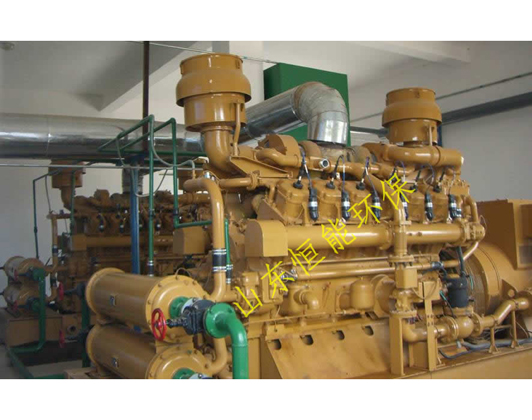湿法烟气脱硫装置目前应用多的是采用石灰石(或石灰)-石膏湿法脱硫工艺。以石灰石(或石灰)作吸收剂洗涤烟气中的二氧化硫,生成亚硫酸钙,再与加入的空气进行氧化反应,后生成石膏, 脱除二氧化硫,净化烟气。整个反应过程均在吸收塔内完成,反应温度一般为50℃左右。
The most commonly used wet flue gas desulfurization device currently uses the limestone (or lime) gypsum wet desulfurization process. Limestone (or lime) is used as absorbent to wash sulfur dioxide in flue gas to generate Calcium sulfite, and then oxidize with added air to generate gypsum, remove sulfur dioxide and purify flue gas. The entire reaction process is completed in the absorption tower, and the reaction temperature is generally around 50 ℃.
其主要工艺流程如下:锅炉引风机出口的烟气,由脱硫增压风机升压经烟气换热器(降温侧)降温后进入吸收塔。当吸收塔采用立式喷雾塔时,吸收塔上部为吸收区,该区布置有喷淋层。吸收塔循环泵将石灰石浆液,亚硫酸钙或石膏混合浆液送入喷咀雾化,雾化浆液自上而下通过吸收塔二氧化硫吸收区,与气流接触产生化学反应,生成亚硫酸钙后流入吸收塔下部反应槽,由氧化风机鼓入空气,亚硫酸钙氧化成硫酸钙-二水石膏。脱硫净化后的烟气经除雾器去除液滴后进入烟道,再由烟气换热器(升温侧)升温后至烟囱排放。
The main process flow is as follows: The flue gas at the outlet of the boiler induced draft fan is pressurized by the desulfurization booster fan and cooled by the flue gas heat exchanger (cooling side) before entering the absorption tower. When the vertical spray tower is adopted for the absorption tower, the upper part of the absorption tower is the absorption area, which is arranged with a spray layer. The circulating pump of the absorption tower sends the limestone slurry, Calcium sulfite or gypsum mixed slurry to the nozzle for atomization. The atomized slurry passes through the sulfur dioxide absorption area of the absorption tower from top to bottom, contacts with the air flow to produce chemical reaction, generates Calcium sulfite, flows into the reaction tank at the lower part of the absorption tower, and is blown into the air by the oxidation fan. Calcium sulfite is oxidized into calcium sulfate gypsum dihydrate. The flue gas after desulfurization and purification enters the flue after removing droplets through the mist eliminator, and is then heated by the flue gas heat exchanger (heating side) before being discharged into the chimney.
由上述工艺流程可知,设置烟气换热器有2个作用。一是降低进入吸收塔的原烟气温度,满足脱硫工艺的要求,其降温的热量用于加热净烟气;二是(也是主要的)利用原烟气的热量加热净烟气,提高排烟温度(一般要求不低于80℃),减轻烟道和烟囱遭受低温湿烟气的腐蚀,同时使烟囱出口的烟气有足够的抬升高度,从而改善周围大气的环境质量。
From the above process flow, it can be seen that setting up a flue gas heat exchanger has two functions. One is to reduce the temperature of the raw flue gas entering the absorption tower to meet the requirements of the desulfurization process, and the cooling heat is used to heat the clean flue gas; The second (and most important) is to use the heat of the original flue gas to heat the clean flue gas, increase the exhaust temperature (generally not less than 80 ℃), reduce the corrosion of the flue and chimney from low-temperature wet flue gas, and at the same time, make the flue gas at the chimney outlet have sufficient lifting height, thereby improving the environmental quality of the surrounding atmosphere.
湿法烟气脱硫装置中换热器的设置
Setting of heat exchangers in wet flue gas desulfurization devices

2.1 烟囱出口排烟温度的选择
2.1 Selection of smoke exhaust temperature at chimney outlet
烟气脱硫装置是否设置烟气换热器,主要取决于排烟温度。当采用半干法、湿氨法、电子束干法或海水脱硫工艺时,吸收塔或反应器后的烟气温度亦在50~65℃,同样存在是否需要设置烟气换热器,提高排烟温度的问题。排烟温度如何确定,不管从环保角度,还是烟囱结构设计方面考虑,我国目前还无标准规定。据了解,国外仅德国从烟气扩散的角度出发,在有关的条例中规定烟囱出口的排烟温度不小于72℃。近年来,国内引进国外技术和设备建设的湿法脱硫装置,多数亦装设了烟气换热器,出换热器后进入烟囱的烟气温度不低于80℃,烟囱出口的排烟温度接近72℃。
Whether a flue gas desulfurization device is equipped with a flue gas heat exchanger mainly depends on the exhaust temperature. When using semi dry method, wet ammonia method, electron beam dry method, or seawater desulfurization process, the flue gas temperature after the absorption tower or reactor is also between 50-65 ℃. There is also the issue of whether to install a flue gas heat exchanger to increase the exhaust gas temperature. There is currently no standard regulation in China on how to determine the exhaust temperature, whether from the perspective of environmental protection or the design of chimney structures. It is understood that only Germany, from the perspective of smoke diffusion, stipulates in relevant regulations that the exhaust temperature at the chimney outlet shall not be less than 72 ℃. In recent years, most wet flue gas desulfurization plants that have introduced foreign technology and equipment have also installed flue gas heat exchangers. The temperature of the flue gas entering the chimney after exiting the heat exchanger is not less than 80 ℃, and the exhaust temperature at the chimney outlet is close to 72 ℃.
2.2 国内、外烟气脱硫装置中烟气换热器的设置
2.2 Setting of flue gas heat exchangers in domestic and foreign flue gas desulfurization devices
根据已了解的情况和国外几家著名的脱硫公司来华技术交流提供的资料,美国大部分火电厂的烟气脱硫装置中未设置烟气换热器,而日本、德国多数火电厂的烟气脱硫装置中设置了烟气换热器。如德国,尽管条例中规定烟囱出口的排烟温度应不低于72℃,但也有少数电厂,烟气脱硫装置中未设烟气换热器,吸收塔出口的低温湿烟气由除雾器去除液滴后直接经电厂冷却塔中央排放,或在吸收塔顶部设湿烟囱排放。
According to the known situation and information provided by several famous foreign desulfurization companies for technical exchange in China, most thermal power plants in the United States do not have flue gas heat exchangers installed in their flue gas desulfurization devices, while most thermal power plants in Japan and Germany have flue gas heat exchangers installed in their flue gas desulfurization devices. For example, in Germany, although regulations stipulate that the exhaust temperature at the chimney outlet should not be lower than 72 ℃, there are also a few power plants that do not have a flue gas heat exchanger in the flue gas desulfurization device. The low-temperature wet flue gas at the absorption tower outlet is directly discharged through the center of the power plant cooling tower after being removed by the mist eliminator, or a wet chimney is installed at the top of the absorption tower for discharge.
日本富士化学公司为我国漳州后石电厂提供的6套海水脱硫装置,也没有设置烟气换热器,吸收塔出口的低温湿烟气直接经240m高的钢制湿烟囱直接排放。在国内已建和在建的部分烟气脱硫装置中烟气换热器的设置情况来看,只有漳州后石电厂的6套海水脱硫装置采用钢制湿烟囱直接排放,还有一部分电厂采用部分烟气脱硫后与未脱硫烟气混合后排放,其余基本上设置了烟气加热器。
The six sets of seawater desulfurization devices provided by Fuji Chemical Company in Japan for the Houshi Power Plant in Zhangzhou, China, do not have flue gas heat exchangers. The low-temperature wet flue gas at the outlet of the absorption tower is directly discharged through a 240m high steel wet chimney. In terms of the installation of flue gas heat exchangers in some of the flue gas desulfurization devices that have been built or are under construction in China, only the six sets of seawater desulfurization devices in Zhangzhou Houshi Power Plant are directly discharged using steel wet chimneys. Some power plants also use partial flue gas desulfurization to mix with undesulfurized flue gas before discharge, while the rest are basically equipped with flue gas heaters.
This article is a friendly contribution from biological desulfurization equipment. For more relevant knowledge, please click on: https://www.hneee.net Sincere attitude. We will provide you with comprehensive services. We will gradually contribute more relevant knowledge to everyone. Stay tuned
